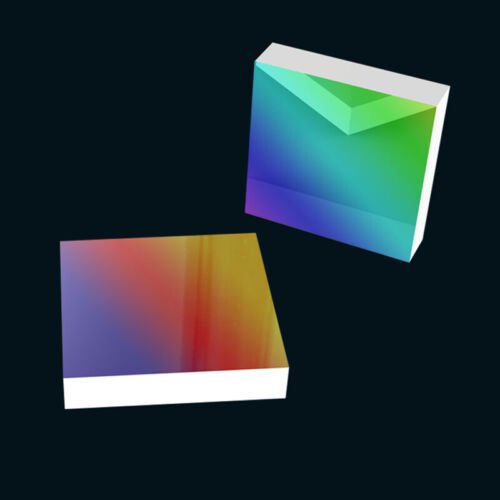An Introduction to Diffraction Gratings
/diffraction gratings. they’re better than good they’re grate.
Check out that spread! this is a typical diffraction pattern using a grating.
Diffraction gratings are optical components that are widely used in various scientific and technological applications. They are made up of a series of closely spaced parallel lines or grooves engraved on a surface, which diffract light and split it into its component wavelengths. This results in the creation of a spectrum, a visual representation of light separated into its individual wavelengths, enabling precise analysis and measurement. These components are integral to both fundamental research and practical applications across a wide range of industries. With their ability to manipulate light effectively, diffraction gratings play a pivotal role in advancing technologies like optical metrology, quantum computing, and medical diagnostics.
The principle behind diffraction gratings is diffraction, the spreading of light as it passes through a small aperture or grating. When light encounters the grating, it diffracts and produces an interference pattern. The separation of wavelengths depends on the grating spacing and the wavelength of light, making diffraction gratings invaluable for analyzing light in spectroscopy, telecommunications, and even astrophysics. This principle has paved the way for breakthroughs in understanding light-matter interactions, enabling developments in imaging systems and energy-efficient optical devices.
History of Diffraction Gratings
The concept of diffraction gratings dates back to James Gregory in 1663, with experimental verification by Thomas Young in 1801. The first practical diffraction grating was invented by Joseph von Fraunhofer in 1821, who used metal plates with thousands of parallel lines to diffract light. Fraunhofer's work laid the foundation for modern spectroscopy by enabling precise analysis of spectral lines, which became essential for understanding atomic and molecular structures. These early gratings allowed scientists to analyze spectral lines, revolutionizing the study of light and material properties.
Significant advancements came in the 19th century, with Henry A. Rowland’s development of a ruling engine in 1884, enabling mass production of gratings. Rowland’s invention allowed for consistent quality and precision, greatly expanding the accessibility of diffraction gratings in scientific research. This innovation also facilitated advancements in astronomical spectroscopy, where gratings became crucial for studying stellar compositions and redshift phenomena.
The invention of holographic diffraction gratings in the 1960s further transformed the field, allowing for gratings with high efficiency and spectral resolution. Unlike mechanically ruled gratings, holographic gratings minimized stray light, offering cleaner and more precise spectra. Modern advancements, such as e-beam lithography and advanced holographic techniques, continue to enhance the accuracy, efficiency, and versatility of diffraction gratings, making them adaptable for emerging technologies such as quantum computing, photonics, and augmented reality systems.
Henry A rowland in 1884 with the first machine made for mass producing diffraction gratings. The engine ruled a large number of closely spaced lines on a metal surface.
Applications of Diffraction Gratings
Spectroscopy
Diffraction gratings are essential in spectroscopy, where they split light into its component wavelengths. This capability allows for the identification and quantification of elements in a sample. Spectroscopy applications span chemistry, physics, astronomy, and environmental science, showcasing the importance of gratings in understanding material properties and chemical compositions. For instance, diffraction gratings enable the detection of exoplanet atmospheres by analyzing the spectral signatures of light passing through them. In environmental monitoring, gratings facilitate the analysis of pollutants and greenhouse gases, contributing to global sustainability efforts.
Optical Communications
In optical communications, diffraction gratings are used to multiplex and demultiplex signals, allowing multiple wavelengths to travel simultaneously through a single optical fiber. For example, they are critical in dense wavelength division multiplexing (DWDM) systems, which enable high-speed data transmission over long distances in modern telecommunications networks. This application enhances data transmission rates and is vital for the infrastructure supporting global internet connectivity. Additionally, advancements in grating design have improved the efficiency of optical signal processing, supporting the rapid growth of 5G networks and cloud computing services.
Laser Technology
Diffraction gratings play a pivotal role in laser systems, enabling precise control of laser beam wavelengths. They are used in laser cutting, welding, and spectroscopy, where accurate wavelength selection is crucial for achieving desired outcomes. Advanced diffraction gratings can also steer and shape laser beams for applications in medical imaging and industrial processing. In medical technology, gratings contribute to the development of laser-based diagnostic tools, improving the accuracy and non-invasiveness of procedures such as photodynamic therapy.
Holography
In holography, diffraction gratings create interference patterns that form three-dimensional images. These gratings allow for the recording and reconstruction of holograms, enabling applications in imaging, data storage, and security features such as anti-counterfeiting measures. Holographic gratings are also being explored for augmented reality (AR) displays, enhancing visual clarity and depth perception. Emerging applications include holographic data storage systems, which promise to revolutionize the capacity and speed of digital storage solutions.
Types of Diffraction Gratings
There are three main types of diffraction gratings: transmission gratings, reflection gratings and holographic gratings. Transmission gratings are used to produce spectrums by transmitting light through the grating, while reflection gratings are used to produce laser beams by reflecting light off the grating.
Transmission Gratings
transmission gratings are great and our puns are grating.
Transmission gratings are made of a transparent material and are designed to transmit light through the grating. As light passes through, it diffracts at the grooves, producing a spectrum. These gratings are commonly used in spectroscopy and optical communication systems, offering high efficiency and accuracy in light separation. They are also used in portable spectrometers, making them essential for field-based environmental monitoring. Recent advancements have improved the durability and efficiency of transmission gratings, enabling their use in harsh environments such as deep-sea exploration and aerospace applications.
Reflection Gratings
reflection diffraction gratings. let us sit and reflect.
Reflection gratings are made of a reflective material and are designed to reflect light back to the observer. The light waves diffract at the lines or grooves of the grating, producing a diffraction pattern that consists of a series of bright and dark bands. The diffracted light forms a series of diffraction orders, each corresponding to a specific diffraction angle, which is equal to the angle of incidence.
Reflection gratings are used in spectroscopy to study the spectral lines of various materials, in optical communications to multiplex or demultiplex signals, and in laser systems to produce a spectrum of light. The advantages of reflection gratings include high efficiency, high accuracy, and the ability to operate in a wide range of environmental conditions. However, reflection gratings also have disadvantages, such as limited transmission, high reflection loss, and the need for accurate alignment..
Holographic Gratings
A holographic diffraction grating is a type of diffraction grating that is made by the process of holography. Holography is a technique for producing a three-dimensional image by recording the interference pattern of light waves. The holographic diffraction grating is produced by exposing a photosensitive material, such as film or a photopolymer, to the interference pattern of two laser beams. The resulting interference pattern forms a grating on the surface of the material, with the lines or grooves of the grating representing the diffraction information of the light.
Holographic diffraction gratings have several advantages over conventional mechanical or embossed gratings. They have a higher diffraction efficiency, which means that more light is diffracted by the grating, and they can have a very high spatial frequency, which allows for a finer grating spacing and improved spectral resolution. They also have the ability to produce gratings with a large surface area and high groove density, which makes them ideal for high-resolution spectroscopy and laser beam steering applications.
In addition to their high performance, holographic diffraction gratings are also versatile and flexible, as they can be easily produced in a variety of shapes and sizes to meet the specific requirements of an application. They can also be produced in a single step, making them less time-consuming and cost-effective compared to conventional mechanical gratings.
Overall, holographic diffraction gratings are a valuable component in various optical systems and applications, such as spectroscopy, optical communications, laser systems, and imaging. They offer high diffraction efficiency, high spatial frequency, and versatility, making them a versatile and valuable component in many optical systems.
Advantages of Diffraction Gratings
High Resolution: Diffraction gratings can produce high-resolution spectra due to their ability to separate light into its component wavelengths with a high degree of accuracy and precision. This is achieved by making the spacing between the grooves in the grating very small.
Wide Wavelength Range: Diffraction gratings are capable of operating over a wide range of wavelengths, making them suitable for use in a variety of applications, including spectroscopy, holography, and laser technology.
Versatility: Diffraction gratings can be made from a variety of materials, including glass, plastic, and metal, and can be fabricated using a variety of techniques, such as holographic, e-beam, and laser lithography methods.
Cost-effective: Compared to other types of spectroscopy equipment, diffraction gratings are relatively inexpensive, making them a cost-effective solution for many applications.
Disadvantages of Diffraction Gratings
Limited Light Efficiency: Diffraction gratings can be less efficient than other types of spectroscopy equipment, as some of the light is lost as it diffracts through the grating.
Require Alignment: Diffraction gratings must be carefully aligned in order to produce accurate spectra. This can be time-consuming and requires a high degree of precision.
Sensitive to Surface Damage: Diffraction gratings are sensitive to surface damage, such as scratches, and this can affect their performance.
Spectral Distortion: Diffraction gratings can produce spectral distortion, which can result in inaccuracies in the spectra produced. This can be caused by factors such as uneven spacing between the grooves, or non-uniformity in the grooves themselves.
Conclusion
Diffraction gratings are indispensable in optical systems, enabling advancements in spectroscopy, optical communications, and laser technology. Their integration into cutting-edge applications such as astrophysics, AR displays, and quantum computing highlights their growing importance in modern science and technology. Despite challenges like alignment sensitivity and efficiency limitations, their benefits, including high resolution and versatility, make them invaluable. Firebird Optics offers a wide range of stock and custom diffraction gratings, designed to meet the needs of both traditional and emerging industries. For inquiries or custom designs, contact us at info@firebirdoptics.com.
Here’s to your success!
Firebird Optics









